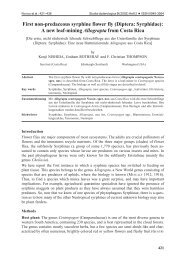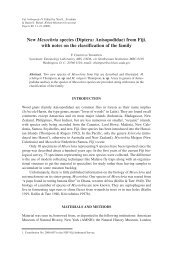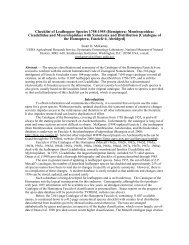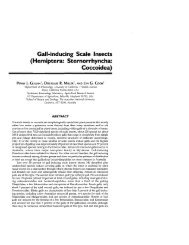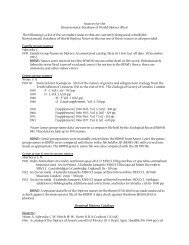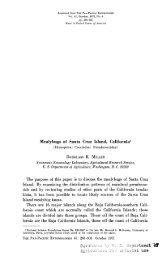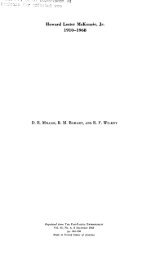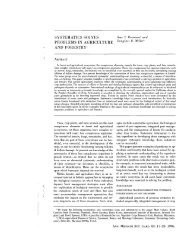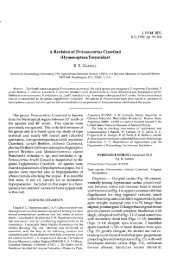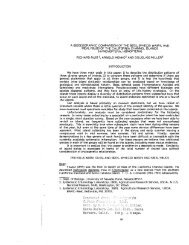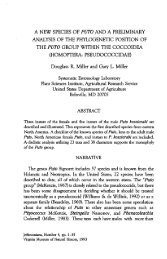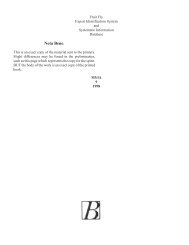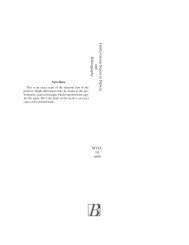Systematic revision of the Family Micrococcidae (Homoptera ...
Systematic revision of the Family Micrococcidae (Homoptera ...
Systematic revision of the Family Micrococcidae (Homoptera ...
You also want an ePaper? Increase the reach of your titles
YUMPU automatically turns print PDFs into web optimized ePapers that Google loves.
- 227 -<br />
Parastigmatic pores near each spiracle, near hind pair <strong>of</strong> legs, and with 1 pore<br />
in lateral area between spiracular clusters, without central loculi, with 5-9<br />
loculi, with 14 (12-16) pores on each side <strong>of</strong> body.<br />
Legs with hind femora each with 3 setae; tibiae with 3; tarsi with 4; tarsal<br />
and claw digitules broken; femur 100 (99-101) fJ. long; tibia 90 (89-91) fJ. long;<br />
tarsus 62 (59-64) fJ. long; femur length divided by tibia +tarsus length 0.6 (0.6<br />
0.7). Antennae 119 (114-124) fJ. long; setae broken except 1 long seta on segment<br />
V 143 fJ. long.<br />
Notes - The description is based on 2 large (aestivating) specimens from 1 locality.<br />
Type material: We have studied <strong>the</strong> syntype series <strong>of</strong> this species and here designate as lectotype<br />
1 <strong>of</strong> 3 second instar females on a slide that is labelled as follows: "Nom: Micrococcus Rungsi /<br />
Balachowsky / Hote: Lygaeum spartum / Localite: Goulmina / Date: 9-VI-34/ Collect.: Rungs /<br />
Determ.: / TYPE 849» A second label is attached to <strong>the</strong> back <strong>of</strong> <strong>the</strong> slide "Micrococcus / rungsi /<br />
Balachowsky / LECTOTYPE & / Paralectotypes» and a map is given <strong>of</strong> <strong>the</strong> position <strong>of</strong> <strong>the</strong> lectotype.<br />
In addition <strong>the</strong>re are-twelve o<strong>the</strong>r paralectotypes; <strong>the</strong> type series is deposited in Museum<br />
National d'Histoire naturelle, Paris, France.<br />
We also have studied <strong>the</strong> syntype series <strong>of</strong> Micrococcus bernardi and here designate as lectotype<br />
1 <strong>of</strong> 2 second instar females on a slide that is labelled as follows: "Nom: Micrococcus /<br />
Bernardi / Rgs / Hote: Nids de Tapinoma / Simrothi Kr. / Localite: Ifrane / Date: 8-X-42 /<br />
Collect.: F Bernard / Determ.: Ch. Rungs / types No 1476» A second label is attached to <strong>the</strong> back<br />
<strong>of</strong> <strong>the</strong> slide "Micrococcus / bernardi / Rungs / LECTOTYPE & / Paralectotypes» and a map is<br />
given <strong>of</strong> <strong>the</strong> position <strong>of</strong> <strong>the</strong> lectotype; <strong>the</strong> slide also contains a pupa. A third label reads" MNHN /<br />
type 53253 ». In addition <strong>the</strong>re are sixteen o<strong>the</strong>r paralectotypes; <strong>the</strong> type series is deposited in<br />
Museum National d'Histoire Naturelle, Paris, France.<br />
Specimens examined: Morocco, Goulmima, VI-9-34, on Lygaeum spartum, C. Rungs, 13<br />
second instar females and 2 fIrst instars on 6 slides (MNHN); Ifrane, Moyen Atlas, X-8-42, associated<br />
with Tapinoma simrothi, M.F. Bernard, 18 second instar females and 1 fourth instar male on<br />
7 slides (MNHN).<br />
Micrococcus silvestrii Leonardi<br />
Because this species was described in detail in <strong>the</strong> previous paper (MAROTrA<br />
et al., 1995) we are providing a diagnosis only. For more detailed information<br />
see MAROTrA et al (l.c.).<br />
Adult female<br />
Diagnosis: Dorsum with longest seta on dorsomedial area <strong>of</strong> metathorax 22<br />
(17-25) fJ. long. Anal plates each with 4 (3-6) setae; longest seta 85 (52-118) fJ.<br />
long. Anal ring with 7 (7-9) setae and 48 (44-56) pores on each half. Apparent



